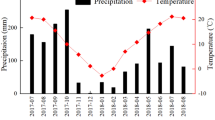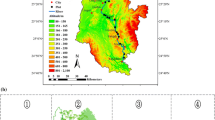Abstract
Purpose
Nowadays, the afforestation by tree planting is one of the most effective measures to combat desertification and restore the degraded land in the global. However, the effects of large-scale afforestation by aerial sowing in desert on soil physicochemical properties has rarely been reported.
Methods
We assessed the variation of topsoil physicochemical properties and their interaction along the nearly 40 years succession and quantified the relatively contribute of soil texture and salinity to nutrients using random forest. Structural equation modeling was applied to obtain a mechanistic understanding of variation of soil nutrients.
Results
The results showed that afforestation by aerial sowing had less effects on increase of topsoil clay (< 2 μm) and silt (2–50 μm), but significant on very fine sand (VFS, 50–100 μm). Soil electrical conductivity (EC) and alkaline cations K+, Ca2+, and Mg2+, except Na+ were significantly increased along vegetation restoration stages. However, the total carbon (TC), nitrogen (TN), and phosphorus (TP) also exhibited a significant improvement in the first 5 years7 and subsequently stabilized for TC and TN but decreased for TP. Random forest and structural equation model show that soil texture and salinity had differentiated effects on soil nutrients. Variance partitioning analysis indicated that soil salinity and texture could explain 43.78% and 31.24% variations of soil nutrients, respectively.
Conclusion
Afforestation by aerial sowing in desert is beneficial to improve topsoil texture and nutrients; however, it was notable that soil phosphorus becoming an increasingly scarce resource along vegetation restoration. Therefore, considering phosphorus supplementation into the further afforestation management is an essential subject.






Similar content being viewed by others
Data availability
The data that support the findings of this study are available on request from the corresponding author. The data are not publicly available due to privacy or ethical restrictions.
References
Archer E (2021) rfPermute: estimate permutation p-values for random forest importance metrics
Bastin JF, Finegold Y, Garcia C, Mollicone D, Rezende M, Routh D, Zohner CM, Crowther TW (2019) The global tree restoration potential. Science 365:76–79
Bauters M, Janssens IA, Wasner D, Doetterl S, Vermeir P, Griepentrog M, Drake TW, Six J, Barthel M, Baumgartner S, Van Oost K, Makelele IA, Ewango C, Verheyen K, Boeckx P (2022) Increasing calcium scarcity along Afrotropical forest succession. Nat Ecol Evol 6:1122–1131
Chen L, Fang K, Wei B, Qin S, Feng X, Hu T, Ji C, Yang Y (2021) Soil carbon persistence governed by plant input and mineral protection at regional and global scales. Ecol Lett 24:1018–1028
Chen Y, Chen L, Cheng Y, Ju W, Chen HYH, Ruan H (2020) Afforestation promotes the enhancement of forest LAI and NPP in China. For Ecol Manag 462:117990
Dai L, Ge J, Wang L, Zhang Q, Liang T, Bolan N, Lischeid G, Rinklebe J (2022) Influence of soil properties, topography, and land cover on soil organic carbon and total nitrogen concentration: a case study in Qinghai-Tibet plateau based on random forest regression and structural equation modeling. Sci Total Environ 821:153440
Delgado-Baquerizo M, Maestre FT, Eldridge DJ, Bowker MA, Ochoa V, Gozalo B, Berdugo M, Val J, Singh BK (2016) Biocrust-forming mosses mitigate the negative impacts of increasing aridity on ecosystem multifunctionality in drylands. New Phytol 209:1540–1552
Deng L, Liu GB, Shangguan ZP (2014) Land-use conversion and changing soil carbon stocks in China’s “Grain-for-Green” Program: a synthesis. Glob Chang Biol 20:3544–3556
Eldridge DJ, Maestre FT, Koen TB, Delgado-Baquerizo M (2018) Australian dryland soils are acidic and nutrient-depleted, and have unique microbial communities compared with other drylands. J Biogeogr 45:2803–2814
Greipsson S, El-Mayas H (1999) Large-scale reclamation of barren lands in Iceland by aerial seeding. Land Degrad Dev 10:185–193
Huang JP, Yu HP, Guan XD, Wang GY, Guo RX (2015) Accelerated dryland expansion under climate change. Nat Clim Chang 6:166–171
Jha, PK, Nai S, Babu CR (1994) Development of an inexpensive legume-Rhizobium inoculation technology which may be used in aerial seeding. J Basic Microbiol 34:231–243
Kottek M, Grieser J, Beck C, Rudolf B, Rubel F (2006) World map of Köppen-Geiger climate classification updated. Meteorol Z 15:259–263
Kou-Giesbrecht S, Menge DNL (2021) Nitrogen-fixing trees increase soil nitrous oxide emissions: a meta-analysis. Ecology 102:e03415
Lauber CL, Hamady M, Knight R, Fierer N (2009) Pyrosequencing-based assessment of soil pH as a predictor of soil bacterial community structure at the continental scale. Appl Environ Microbiol 75:5111–5120
Li J, Nie M, Powell JR, Bissett A, Pendall E (2020) Soil physico-chemical properties are critical for predicting carbon storage and nutrient availability across Australia. Environ Res Lett 15:094088
Li X, Li Y, Xie T, Chang Z, Li X (2022) Recovery of soil carbon and nitrogen stocks following afforestation with xerophytic shrubs in the Tengger Desert. North China Catena 214:106277
Li XR, He MZ, Duan ZH, Xiao HL, Jia XH (2007) Recovery of topsoil physicochemical properties in revegetated sites in the sand-burial ecosystems of the Tengger Desert, northern China. Geomorphology 88:254–265
Li Y, Awada T, Zhou X, Shang W, Chen Y, Zuo X, Wang S, Liu X, Feng J (2012) Mongolian pine plantations enhance soil physico-chemical properties and carbon and nitrogen capacities in semi-arid degraded sandy land in China. Appl Soil Ecol 56:1–9
Liu YF, Liu Y, Shi ZH, López-Vicente M, Wu GL (2020) Effectiveness of re-vegetated forest and grassland on soil erosion control in the semi-arid Loess Plateau. CATENA 195:104787
Long M, Wu H-H, Smith MD, La Pierre KJ, Lü X-T, Zhang H-Y, Han X-G, Yu Q (2016) Nitrogen deposition promotes phosphorus uptake of plants in a semi-arid temperate grassland. Plant Soil 408:475–484
Ma Q, Wang X, Chen F, Wei L, Zhang D, Jin H (2021) Carbon sequestration of sand-fixing plantation of Haloxylon ammodendron in Shiyang River Basin: storage, rate and potential. Global Ecol Conserv 28:e01607
Perri S, Suweis S, Entekhabi D, Molini A (2018) Vegetation controls on dryland salinity. Geophys Res Lett 45:11669–11682
Porto P, Walling DE, Callegari G (2009) Investigating the effects of afforestation on soil erosion and sediment mobilisation in two small catchments in Southern Italy. CATENA 79:181–188
Rath KM, Fierer N, Murphy DV, Rousk J (2019) Linking bacterial community composition to soil salinity along environmental gradients. ISME J 13:836–846
Rousk J, Baath E, Brookes PC, Lauber CL, Lozupone C, Caporaso JG, Knight R, Fierer N (2010) Soil bacterial and fungal communities across a pH gradient in an arable soil. ISME J 4:1340–1351
Ryan J (1983) Phosphorus and its utilization in soils of dry regions. Geoderma 29:341–354
Su YZ, Zhao WZ, Su PX, Zhang ZH, Wang T, Ram R (2007) Ecological effects of desertification control and desertified land reclamation in an oasis–desert ecotone in an arid region: a case study in Hexi Corridor, northwest China. Ecol Eng 29:117–124
Torres L, Abraham EM, Rubio C, Barbero-Sierra C, Ruiz-Pérez M (2015) Desertification research in Argentina. Land Degrad Dev 26:433–440
Walker LR, Wardle DA, Bardgett RD, Clarkson BD (2010) The use of chronosequences in studies of ecological succession and soil development. J Ecol 98:725–736
Wang G, Munson SM, Yu K, Chen N, Gou Q (2020) Ecological effects of establishing a 40-year oasis protection system in a northwestern China desert. CATENA 187:104374
Xiao X, Wei X, Liu Y, Ouyang X, Li Q, Ning J (2015) Aerial seeding: an effective forest restoration method in highly degraded forest landscapes of sub-tropic regions. Forests 6:1748–1762
Xu Z, Li Z, Liu H, Zhang X, Hao Q, Cui Y, Yang S, Liu M, Wang H, Gielen G, Song Z (2018) Soil organic carbon in particle-size fractions under three grassland types in Inner Mongolia. China J Soils Sediments 18:1896–1905
Yu K, Wang G (2018) Long-term impacts of shrub plantations in a desert-oasis ecotone: Accumulation of soil nutrients, salinity, and development of herbaceour layer. Land Degrad Dev 29:2681–2693
Zhang L, Hong G, Li Z, Gao X, Wu Y, Wang X, Wang P, Yang J (2018) Assessment of the ecosystem service function of sandy lands at different times following aerial seeding of an endemic species. Sustainability 10:902
Funding
This study was supported by the West Light Foundation of the Chinese Academy of Sciences (No. [2020]82), Key technology projects of Inner Mongolia Autonomous Region (Grant No. 2020GG0306), Science and Technology Plan Projects of Alxa League (Grant No. AMY2020-18), and Natural Science Foundation of Gansu Province (No. 21JR7RA038).
Author information
Authors and Affiliations
Contributions
The manuscript has been read and approved by all named authors.
Corresponding author
Ethics declarations
Conflicts of interests
The authors declare no competing interests.
Additional information
Responsible editor: Yanzheng Gao
Publisher's Note
Springer Nature remains neutral with regard to jurisdictional claims in published maps and institutional affiliations.
Supplementary Information
Below is the link to the electronic supplementary material.
Rights and permissions
Springer Nature or its licensor (e.g. a society or other partner) holds exclusive rights to this article under a publishing agreement with the author(s) or other rightsholder(s); author self-archiving of the accepted manuscript version of this article is solely governed by the terms of such publishing agreement and applicable law.
About this article
Cite this article
Chen, W., Yu, T., Han, T. et al. Effects of afforestation by aerial sowing on topsoil physicochemical properties in the sandy desert, NW China. J Soils Sediments 23, 2417–2427 (2023). https://doi.org/10.1007/s11368-023-03486-y
Received:
Accepted:
Published:
Issue Date:
DOI: https://doi.org/10.1007/s11368-023-03486-y




